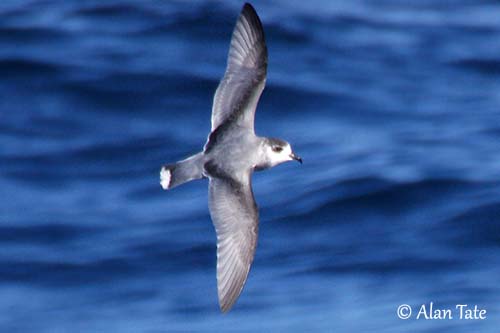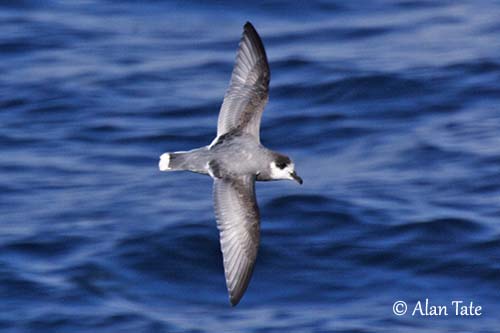
Fr: Prion bleu
Ang: Blue Petrel
All: Blausturmvogel
Esp: Petrel Azulado
Ita: Petrello azzurro
Nd: Blauwe Stormvogel
Sd: Blåpetrell
Photographers:
Otto Plantema
Trips around the world
Alan & Ann Tate
AA Bird Photography
Text by Nicole Bouglouan
Sources:
HANDBOOK OF THE BIRDS OF THE WORLD vol 1 by Josep del Hoyo-Andrew Elliot-Jordi Sargatal - Lynx Edicions - ISBN: 8487334105
A Complete Guide to Antarctic Wildlife by Hadoram Shirihai and Illustrated by Brett Jarrett - Edited by Guy M. Kirwan - ALUL.A Press Oy, Finland - ISBN 9519894705
BirdLife International (BirdLife International)
Department of Sustainability, Environment, Water, Population and Communities
New Zealand birds and birding (Narena Olliver)
Wikipedia, the free encyclopaedia
Blue Petrel
Halobaena caerulea
Procellariiformes Order – Procellariidae Family
INTRODUCTION:
The Blue Petrel is the sole member of genus Halobaena. Its plumage pattern is very similar to that of prions of genus Pachyptila, but it differs from prions in some ecological aspects and morphological features.
The Blue Petrel is found in Antarctic and subantarctic waters. Its global population appears to be stable. The main threat is the predation by rats and cats on some breeding islands.
DESCRIPTION OF THE BIRD:
Biometrics:
Length: 26-32 cm
Wingspan: 58-71 cm
Weight: 150-250 g
The adult has grey-blue upperparts with conspicuous blackish M across the upperwing, well visible in flight. The three outermost primaries are blacker. The rearmost scapulars and the tertials are dark grey with white tips. The tail is grey-blue with dark indistinct subterminal band and broad white tip, slightly narrower on the outermost rectrices.
The underparts, including wings and tail, are white.
On the head, a blackish cap extends to and around the eye and onto the neck sides, forming a dark partial or sometimes complete collar. It contrasts strongly with the white forehead and throat.
The bill is blackish-grey to bluish-black. The eyes are blackish-brown. Legs and webbed feet are blue-grey with pink webs.
Male and female have similar plumage, but the female is smaller with shorter wings.
The juvenile is browner on the upperparts, and it has greyer forehead.

RANGE:
The Blue Petrel is circumpolar in Southern Ocean. It breeds on South Georgia, Prince Edward, Marion, Crozet (east), Kerguelen and Macquarie Islands and in Cape Horn.
Outside the breeding season, it may reach S Australia, New Zealand, S South America and South Africa, although some birds may remain year-round close to their breeding colonies.
HABITAT:
The Blue Petrel is pelagic. It occurs in the cold Antarctic and subantarctic waters. On the breeding islands, the colonies are established on tussock-covered coastal slopes. It nests in self-excavated burrow.
CALLS ANS SONGS: SOUNDS BY XENO-CANTO
The Blue Petrel is usually silent at sea but it is more vocal at colonies. The adults produce pigeon-like cooing “kuk-kuk-kuk coo-coo” fairly similar to prions of genus Pachyptila. These calls are given mainly from the ground at night, but also in flight. They also give cackling calls.
The calls vary between the different islands within the same group or archipelago. The heaviest males usually give faster calls.
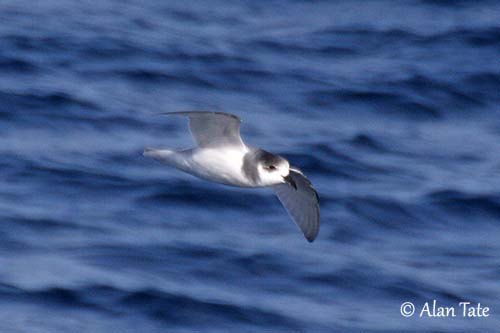
BEHAVIOUR IN THE WILD:
The Blue Petrel feeds on crustaceans, especially krill of genus Euphausia, small fish and squid caught by dipping while flying or swimming.
It uses several fishing techniques such as surface-dipping, surface-seizing and surface-diving. It may occasionally perform pursuit-diving.
It often associates with prions, and forages sometimes around the large cetaceans which lead the preys close to the surface. It may fly alongside the large vessels.
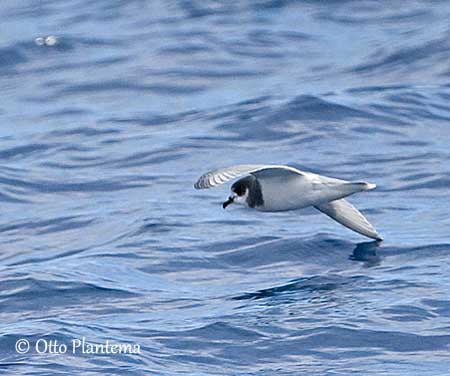
The Blue Petrel breeds in colonies in self-excavated burrow on grassy slopes. They are monogamous. They are nocturnal at colonies, in order to avoid predation from skuas. The colonies are dense with two nests/square metre. Both parents share all the nesting duties. Most courtship and sexual activities take place inside the burrow.
The Blue Petrel adult may be largely sedentary. They disperse first to adjacent waters. They leave the breeding colonies between late January and early March.
Non-breeding birds and young of the year may reach SE Australian waters between September and November.
It returns to the colonies in late August/early September.
The Blue Petrel flies mainly close to the sea surface and soars more than other prions. Its flight is less erratic and more buoyant.
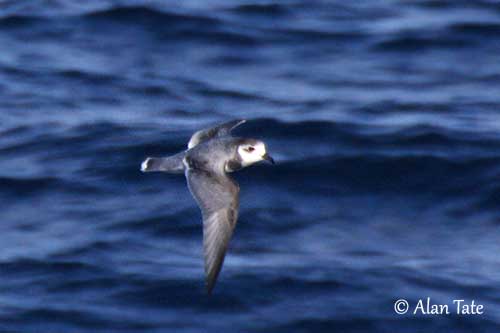
REPRODUCTION OF THIS SPECIES:
The breeding season starts in August-September and lasts until February, with peak of laying in October, after a pre-laying exodus by the breeding adults.
They breed in dense colonies in self-excavated burrows. The breeding colonies are established on coastal slopes covered with tussock grass. The burrow is sometimes lined with twigs and leaves.
The female lays a single white egg. Both adults share the incubation during 45-49 days. At hatching, the chick is covered with bluish-grey down. It is brooded for three days. Both parents feed it by regurgitation. It fledges between 43 and 60 days after hatching, usually in February.
PROTECTION / THREATS / STATUS:
The Blue Petrel has stable populations in spite of predation by cats and rats on some islands, and skuas in Kerguelen Archipelago.
The global population was estimated at least at 3,000,000 individuals in 2004.
The Blue Petrel is currently evaluated as Least Concern.
